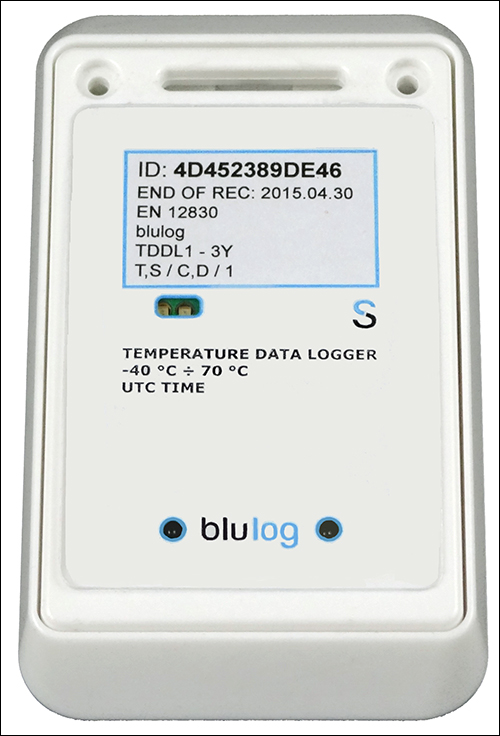European food retailer Eurocash Group is deploying an active RFID-based solution to manage the temperatures of its coolers at its Polish stores and warehouses. Once fully installed, the system—provided by Blulog—will include wireless sensors deployed at 200 warehouses and other distribution points throughout Poland. The technology will monitor the temperatures of all the company’s products—dry, fresh and frozen—as they move through the supply chain to stores and, ultimately, to consumers. The system is intended to ensure a high level of product quality, Eurocash reports, while minimizing losses resulting from perceived temperature changes.
Blulog, a French-Polish temperature-monitoring technology company based in Poznań, makes data loggers that employ wireless technology, including active ultrahigh-frequency (UHF), to transmit sensor data to a server. Eurocash was one of Blulog’s first customers when the firm was founded in 2014, says Jérémy Laurens, Blulog’s CEO.
The deployment has taken place in various phases. Initially, Eurocash tested several of Blulog’s data loggers at a single warehouse, after which it began rolling out the technology for other sites as well. The initial data loggers transmitted to hubs connected to a computer via a USB cable, the company notes. In 2015, Blulog transitioned to active UHF-enabled loggers transmitting to a wireless gateway powered over Ethernet.
Last year, the company began offering Wi-Fi-based gateways that could send data directly to the Blulog software residing in the cloud. As Laurens explains, “The idea was to simplify the installation” at the locations that, by this time, also included several delicatessens that sell Eurocash products.
In late 2016, Eurocash signed a contract to roll out the technology at 200 sites. Each warehouse typically comes with two large, cold storage rooms—one for refrigeration and one for frozen goods—as well as another large area for storing dry goods.
The retailer hopes to better manage the conditions to which its products are exposed. This would help the company to ensure that problems are addressed immediately, and that it knows definitively whether a particular product needs to be discarded.
“The most important challenge we can overcome is to eliminate the human factor,” says Karol Maćkowiak, Eurocash’s head of quality department. The use of human workers to collect and verify temperatures not only is time-consuming and labor-intensive, he notes, but also provides the potential for error. In addition, it simply can’t be done as often as an automated system can provide data. “The temperature of transport or storage of food is one of the parameters that I would like to provide at the highest possible level—100 percent,” Maćkowiak states. He seeks certainty, he says, as well as proof that measurements were taken, and what the results were, especially with regard to when temperatures exceeded acceptable perimeters and for how long.
Within each warehouse, Eurocash uses Blulog’s UHF and Near Field Communication (NFC) data loggers, with three or four installed in each room. Some warehouses require 26 loggers or more to cover the entire storage area. The loggers are the size of a credit card, and can capture data and forward it to a gateway at a distance of up to 700 meters (2,300 feet). The loggers operate with a coin cell battery that has a typical life span of about three years.
The gateway, in turn, is connected via either Wi-Fi or an Ethernet cable. Typically, only one or two gateways are necessary. Each gateway transmits to Blulog’s cloud-based software. At some locations, Ethernet cables are used, while others utilize the existing Wi-Fi network.
While loggers transmit data to the gateway via active UHF, they are also equipped with an NFC radio that, when necessary, can transmit data at 13.56 MHz. For instance, in the event of an Internet failure or power outage preventing data transmission by the gateway, individuals equipped with NFC-enabled mobile phones can simply go to each logger and capture the sensor data directly from it, without requiring an app.
Eurocash’s employees are installing the system at each site themselves, using a logger holder and screws or double-sided adhesives to mount them to walls. Since the system was installed, Maćkowiak says, store profits are up due to labor savings, as well as better data enabling food not to be discarded either because it becomes too warm or cold, or because the temperature history cannot be verified.
In the long term, Maćkowiak says, he wants to make the technology universal across the company so that he can see temperature and humidity changes at all locations, from the initial collection area to the store. This would also allow him to view air flow and gas concentration, such as ethylene gases that can build up around fruits or vegetables.
As part of this effort, Laurens says, Eurocash and Blulog are now testing the technology on trucks. In this case, the data logger captures sensor data, which it transmits to the gateways when the trucks pull into a warehouse or store using such devices. In that way, the company not only has a record of the temperatures to which the food has been exposed, but also knows when it was delivered to or departed from a specific location.
During the coming year, Blulog also plans to release a QR code functionality that would enable companies like Eurocash to share temperature records with customers shopping for their products. The QR code would be attached to the front of a refrigerator or freezer. Customers could use their mobile phone to scan the QR code, which would take them to a server where BlueConsole software would link the QR code for that cooler to the products stored inside within, and then display historic sensor data for those goods on the customer’s phone. “Eurocash wants to be among the first to showcase this technology,” Laurens says.



